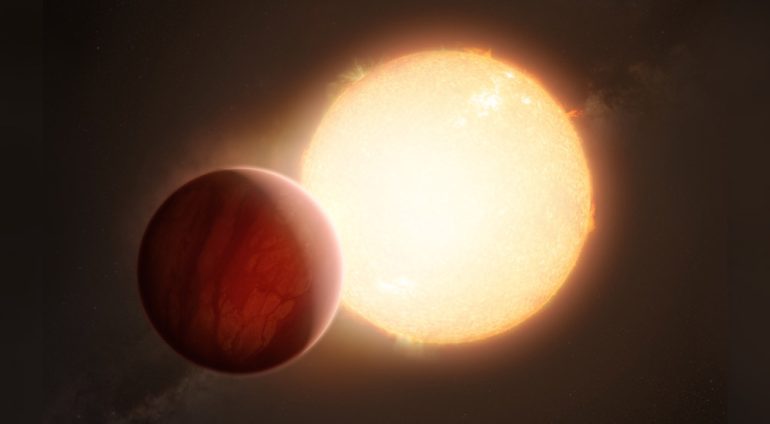Surprising discovery: Astronomers have detected for the first time the element barium in the gas envelopes of two extrasolar gas giants – the heaviest element ever discovered in the atmosphere of an exoplanet. How this relatively heavy, dense metal gets into the upper atmospheres of these two hot Jupiters and why it doesn’t immediately rebound is still unclear. Previously unknown chemical and atmospheric processes may be behind this.
Exoplanets have hot Jupiter extremities: These gas giants orbit their star so closely that their day side remains open several thousand degrees is heated. The chemistry in its gas shell is correspondingly exotic: under these conditions, the metal becomes gaseous and even stable molecules disintegrate. The night side of some hot Jupiters is still so hot that it rains liquid iron, drops titanium dioxide, or forms clouds of liquid minerals.
At the same time, however, hot Jupiters provide nearly perfect conditions for studying their gas envelopes. Because they orbit close to the star and their gas envelope is usually greatly inflated. This enables astronomers to detect and spectrometrically analyze the light radiating through their atmospheres as planets pass in front of their star.
Ultra-hot gas giant in sight
Astronomers led by Tomas Azevedo Silva of the University of Porto have now taken a closer look at two of these ultra-hot gas giants. Hot Jupiter, about 640 light years away WASP-76b It takes only 1.8 days to orbit its star. Earlier observations had already shown that its daytime temperatures warm up to 2,400 degrees, while the night part is still around 1,500 degrees. These temperature differences create strong winds that blow vaporized iron and other metals such as magnesium, cobalt, chromium or strontium toward the night, where they condense into droplets.
gas giant, about 850 light years away WASP-121b is uniformly hot and has an orbital period of 30.6 hours. Spectral data show that droplets of metals, but also minerals such as perovskite, forsterite and corundum, formed on the night side. These “liquid gems” also form clouds over the hot gas giant and rain down from the sky at night. To learn more about the exotics of these two planets, Silva and his team examined them with the high-resolution Espresso Spectrograph at the European Southern Observatory’s Very Large Telescope in Chile.
the element barium on both planets
The results showed something surprising: In the upper atmospheres of both exoplanets, astronomers discovered spectral lines of barium, an alkaline Earth metal that, with an atomic mass of about 137, is about 2.5 times heavier than iron. “It is the heaviest element ever found in the atmosphere of an exoplanet,” the researchers explain. The spectral lines showed that barium occurs as a positively charged ion in the planetary gas envelope.
“In a way, it was an accidental finding because we didn’t expect or look for barium,” Silva says. The alkaline earth metal melts at about 727 °C under normal conditions and evaporates at 1,637 °C, so it may be gaseous, at least temporarily, over the two gas giants. “The presence of barium ions on both exoplanets may indicate that this heavy element is common in the atmospheres of super-hot Jupiters,” Silva and his team speculate.
mystery about the location
Even more surprising, however, is where the astronomers detected barium: “What is really perplexing and paradoxical: why is there such a heavy element in the upper layers of the atmospheres of these planets?” Silva asks. Given the high gravity of the planets, rapid sinking of heavier elements such as barium can be expected and occurs only in the lower layers of the planetary gas envelope.
This raises the question that due to what natural process this heavy element could be present at such heights on these two exoplanets. “We are not yet clear about the mechanism,” explains Silva’s colleague Olivier Damangian. According to astronomers, however, it may well be that the atmosphere of hot Jupiter has processes that are unknown from other planets. (Astronomy and Astrophysics, 2022; doi:10.1051/0004-6361/202244489,
Source: European Southern Observatory (ESO)

Internet fan. Alcohol expert. Beer ninja. Organizer. Certified tv specialist. Explorer. Social media nerd.





